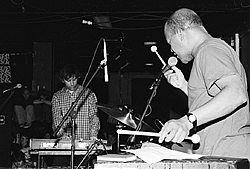

During the 1980s, the concept of "guitar as noisemaker" ruled New York's rock scene, as bands like DNA and Red Milk began producing rhythm filled music movement eventually morphed into the more accessible post-punk and post-rock, it never really went away, as evident by Lee Ranaldo and William Hooker's powerful set at the 'Sco last Saturday night.

Ranaldo got on stage first, treating the audience to the wonderfully unsettling sound that can only be obtained through the use of multiple effects boxes. Aside from the usual distortion and delay pedals, Ranaldo also relied on a huge box that held an additional six pedals. The music he played was confrontational and loud to be sure, but it was also dreamy and expansive. The sad reductiveness found in most so-called "noise rock" was absent, mostly because Ranaldo refused to base his passionate playing on mere aggression.
Instead, he would often play a single chord for minutes at a time, creating an almost ambient feel. Later he switched from guitar to a severely damaged organ, which he treated like a theroman, extracting sounds from the tattered machine by waving an amplifier chord around its power outlet. Later, he read from a book of his poetry titled "Moroccan Travel Journal." The poetry, filled with musings on the majestic qualities of North Africa as well as his reverent attitude towards the famed Musicians of Jojouka gave the impression that Ranaldo was a man still very much a student of music, and by no means satisfied by the watered down alterna-rock that his band Sonic Youth helped to spawn.
Hooker, a respected jazz player, countered Ranaldo's sprawling white-noise with his frenetic drumming. Clearly a master of improvisation, Hooker never missed a beat as he accompanied Ranaldo to some uncharted sonic world, making sure that the necessary rhythmic order of the music continued. Hooker's drum sounds varied quite a bit, ranging from a few brushes on the cymbals to an all out assault on his snare. It was a joy to watch such an accomplished player taking musical risks, and succeeding.

Hooker also contributed poetry. His style was much more emotive, as he stepped from behind his kit to recite loudly and powerfully his takes on contemporary New York City. Hooker's poetry was better appreciated by the audience, as it was more firmly based on the experienced life, rather than the idealistic musings of Ranaldo's North African excursion.
The set, which lasted about 50 minutes and included only one break, was the essential rock show of the year. Juxtaposing these two downtown players onto the quaint hamlet of Oberlin made for an intense backdrop for the chaos occurring on stage. The striking originality of the works thrilled the crowded audience, who realized that they were observing two legitimate downtown legends testing new waters.
The Oberlin-based group Back to Junk opened the show with strong 45 minute set. The group included double-degree first-year saxophonist David Reminick, college sophomore Peter Witte on guitar, conservatory sophomores Brian Chase and Allan Baker on drums and piano respectively, and college senior bassist Rob Lehman, played two noisy compositions routed in John Zorn and the New York Dolls. Many audience members stepped back a few steps, obviously surprised by their fellow students' notable lack of sang froid. Expect exciting things from this quintet as they evolve.
Power Trip: Lee Renaldo played a noisy and intriguing set at the 'Sco last Saturday.Breakin' it down: Lee Ranaldo and William Hooker played the 'Sco last Saturday to a baffled audience. (photos by Mike Kabakoff)
Copyright © 1998, The Oberlin Review.
Volume 126, Number 17, March 6, 1998
Contact us with your comments and suggestions.